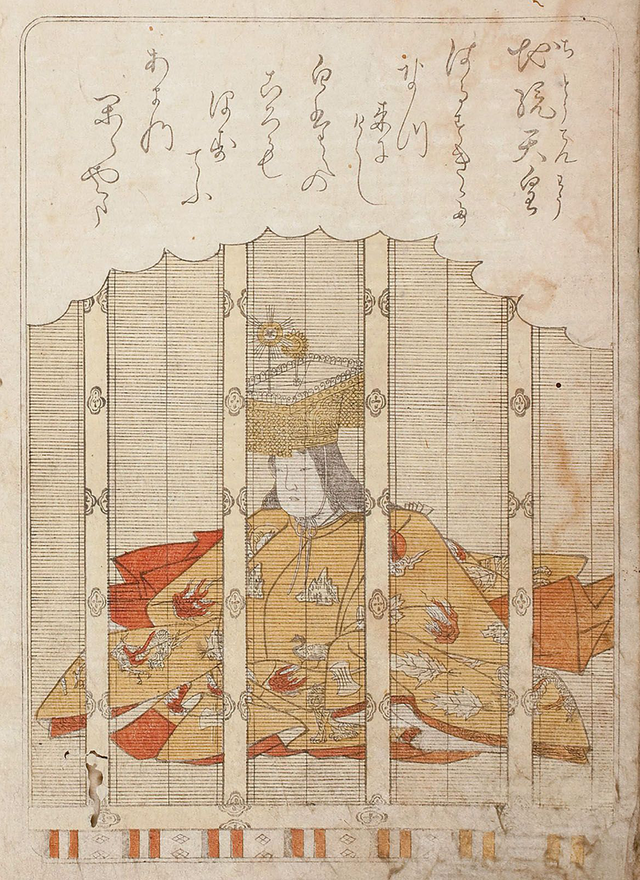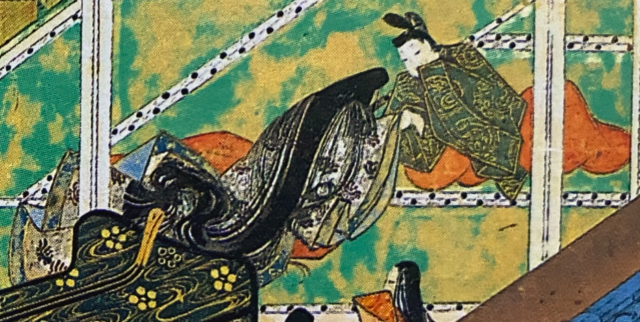| Portrait |
Name |
Spouse |
Tenure |
Life details |
 |
Himetataraisuzu-hime
媛蹈鞴五十鈴媛 |
Emperor Jimmu |
660[11]–581 BC[12]
(81 years) |
Daughter of Kotoshironushi. Married Emperor Jimmu in 681 BC.[11] Gave birth to Emperor Suizei and two other children. Empress dowager from 581 BC.[12] |
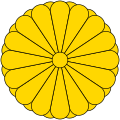 |
Isuzuyori-hime
五十鈴依媛命 |
Emperor Suizei |
580[12]–548 BC[13]
(32 years) |
Daughter of Kotoshironushi. Gave birth to Emperor Annei. Empress dowager from 548 BC.[13] |
 |
Nunasokonakatsu-hime
渟名底仲媛命 |
Emperor Annei |
546[14]–510 BC[15]
(36 years) |
Daughter of Prince Kamo; niece of Himetataraisuzu-hime and Isuzuyori-hime. Gave birth to Emperor Itoku and two other children. Empress dowager from 510 BC.[15] |
 |
Amonotoyototsu-hime
天豊津媛命 |
Emperor Itoku |
509[15]–475 BC[16]
(34 years) |
Daughter of Prince Okisomimi; granddaughter of Emperor Annei and Nunasokonakatsu-hime. Gave birth to Emperor Kōshō and one other child. Empress dowager from 475 BC.[16] |
 |
Yosotarashi-hime
世襲足媛 |
Emperor Kōshō |
447[16]–392 BC[17]
(55 years) |
Daughter of Ame no Oshio no Mikoto. Gave birth to Emperor Kōan and one other child. Empress dowager from 392 BC.[17] |
 |
Oshihime
押媛 |
Emperor Kōan |
367[17]–290 BC[18]
(77 years) |
Daughter of Prince Ametarashihikokunioshihito; granddaughter of Emperor Kōshō and Yosotarashi-hime. Gave birth to Emperor Kōrei and one other child. Empress dowager from 290 BC.[18] |
 |
Kuwashi-hime
細媛命 |
Emperor Kōrei |
289[18]–214 BC[19]
(74 years) |
Daughter of Shiki no Agatanushi Oome. Gave birth to Emperor Kōgen. Empress dowager from 214 BC.[19] |
 |
Utsushikome
欝色謎命 |
Emperor Kōgen |
208[20]–157 BC[21]
(50 years) |
Daughter of Oyakuchisukune. Gave birth to Emperor Kaika and three other children. Empress dowager from 157 BC.[21] |
 |
Ikagashikome
伊香色謎命 |
Emperor Kaika |
152[21]–97 BC[22]
(75 years) |
Daughter of Ōhesoki. Was a concubine of Emperor Kōgen, with whom she had one child. Later married Emperor Kaika and gave birth to Emperor Sujin and one other child. Empress dowager from 97 BC.[22] |
 |
Mimaki-hime
御間城姫 |
Emperor Sujin |
97[22]–29 BC[23]
(68 years) |
Daughter of Prince Ōhiko; granddaughter of Emperor Kōgen and Utsushikome. Gave birth to Emperor Suinin and five other children. Empress dowager from 29 BC.[23] |
 |
Saho-hime
狭穂姫命 |
Emperor Suinin |
28[24]–25 BC[25]
(3 years) |
died 25 BC[25]
Daughter of Prince Hikoimasu; granddaughter of Emperor Kaika. Gave birth to one child. Died during the rebellion of her older brother, Sahohiko.[25] |
 |
Hibasu-hime
日葉酢媛命 |
15 BC[26]–AD 3[27]
(18 years) |
died AD 3[27]
Daughter of Prince Tanba-no-Michinoushi; great-granddaughter of Emperor Kaika; niece of Saho-hime. Gave birth to Emperor Keikō and four other children. |
 |
Harima no Inabi no Ōiratsume
播磨稲日大郎姫 |
Emperor Keikō |
72[28]–122[29]
(40 years) |
died 122[29]
Daughter of Prince Wakatakehiko; granddaughter of Emperor Kōrei. Gave birth to four children. |
 |
Yasakairi-hime
八坂入媛命 |
122[29]–132[30]
(10 years) |
Daughter of Prince Yasakairihiko; granddaughter of Emperor Sujin; half-cousin of Emperor Keikō. Gave birth to Emperor Seimu and 11 other children. Empress dowager from 132.[30] |
 |
Okinagatarashi-hime
気長足姫尊 |
Emperor Chūai |
193[31]–201[32]
(8 years) |
169–269
(100 years)
Daughter of Okinaganosukune; great-great-great-granddaughter of Emperor Kaika. Gave birth to Emperor Ōjin and served as his regent from 201 until 269. Empress dowager from 201.[32] |
 |
Nakatsu-hime
仲姫命 |
Emperor Ōjin |
271[33]–313[34]
(41 years) |
Daughter of Homudamawaka. Gave birth to Emperor Nintoku and two other children. Empress Dowager from 313.[34] |
 |
Princess Iwa
磐之媛命 |
Emperor Nintoku |
314[35]–347[36]
(33 years) |
died 347[36]
Daughter of Katsuragi no Sotsuhiko; great-great-great-granddaughter of Emperor Kōgen. Poet. Gave birth to Emperor Richū, Emperor Hanzei, Emperor Ingyō and one other child. |
 |
Princess Yata
八田皇女 |
appointed 350[36] |
Daughter of Emperor Ōjin. |
 |
Princess Kusakanohatabino
草香幡梭皇女 |
Emperor Richū |
appointed 405[37] |
Daughter of Emperor Ōjin. Gave birth to Princess Nakashi. |
 |
Oshisaka no Ōnakatsuhime
忍坂大中姫 |
Emperor Ingyō |
413[38]–453[39]
(40 years) |
Daughter of Prince Wakanuke no Futamata; granddaughter of Emperor Ōjin. Gave birth to Emperor Ankō, Emperor Yūryaku and seven other children. Empress dowager from 453.[39] |
 |
Princess Nakashi
中磯皇女 |
Emperor Ankō |
appointed 455[40] |
Daughter of Emperor Richū and Kusakanohatabino-hime; niece of Emperor Ankō. Previously married to Prince Ōkusaka, son of Emperor Nintoku, and had one child with him. Became a concubine of Emperor Ankō in 454.[40] |
 |
Kusaka no Hatabi no hime
草香幡梭姫皇女 |
Emperor Yūryaku |
appointed 457[41] |
Daughter of Emperor Nintoku. |
 |
Princess Naniwa no Ono
難波小野王 |
Emperor Kenzō |
485[42]–489[43]
(4 years) |
died 489[43]
In the Nihon Shoki: daughter of Prince Oka-no-Wakugo; great-granddaughter of Emperor Ingyō. In the Kojiki: daughter of Prince Iwaki; granddaughter of Emperor Yūryaku. Committed suicide due to fears over disrespecting Emperor Ninken when he was crown prince.[43] |
 |
Princess Kasuga no Ōiratsume
春日大娘皇女 |
Emperor Ninken |
appointed 488[44] |
Daughter of Emperor Yuryaku. Gave birth to Emperor Buretsu, Princess Tashiraka, Princess Tachibana no Nakatsu and six other children. |
 |
Kasuga no Iratsume
春日娘子 |
Emperor Buretsu |
appointed 499[45] |
Unknown parents. |
 |
Princess Tashiraka
手白香皇女 |
Emperor Keitai |
appointed 507[46] |
born 489
Daughter of Emperor Ninken and Princess Kasuga no Ōiratsume. Gave birth to one child. |
 |
Princess Kasuga no Yamada
春日山田皇女 |
Emperor Ankan |
appointed 534[47] |
Daughter of Emperor Ninken. Married Emperor Ankan in 513.[48] |
 |
Princess Tachibana no Nakatsu
橘仲皇女 |
Emperor Senka |
536[49]–539[50]
(3 years) |
Daughter of Emperor Ninken and Princess Kasuga no Ōiratsume. Gave birth to five children. Empress dowager from 539.[50] |
 |
Princess Ishi-hime
石姫皇女 |
Emperor Kinmei |
540[51]–572[52]
(32 years) |
Daughter of Emperor Senka and Princess Tachibana no Nakatsu. Gave birth to Emperor Bidatsu and two other children. Empress dowager from 572. |
 |
Hirohime
広姫 |
Emperor Bidatsu |
575[53][54]
(10 months) |
died 575
Daughter of Prince Okinaga-no-Mate; great-great-granddaughter of Emperor Ōjin. Gave birth to three children. |
 |
Princess Nukatabe
額田部皇女 |
576[54]–585
(9 years) |
554–628
(74 years)
Daughter of Emperor Kinmei. Gave birth to eight children. Empress regnant from 592. |
 |
Princess Hashihito no Anahobe
穴穂部間人皇女 |
Emperor Yōmei |
586[55]–587
(1 year) |
560–621
(61 years)
Daughter of Emperor Kinmei. Married to Emperor Yōmei in 564. Gave birth to four children. |
 |
Princess Takara
宝皇女 |
Emperor Jomei |
630[56]–641
(11 years) |
594–661
(67 years)
Daughter of Prince Chinu; great-granddaughter of Emperor Bidatsu. Gave birth to Emperor Tenji, Emperor Kōtoku and one other child. Empress regnant from 642 until 645 and from 655 until 661. |
 |
Princess Hashihito
間人皇女 |
Emperor Kōtoku |
appointed 645 |
died 665
Daughter of Emperor Jomei and Princess Takara. |
 |
Yamato Hime no Ōkimi
倭姫王 |
Emperor Tenji |
appointed 668[57] |
Daughter of Prince Furuhito no Ōe; granddaughter of Emperor Jomei. Poet. Gave birth to Emperor Tenmu. |
 |
Princess Unonosarara
鸕野讃良皇女 |
Emperor Tenmu |
673[58]–686
(13 years) |
645–703
(57–58 years)
Daughter of Emperor Tenji. Gave birth to one child. Empress regnant from 686 until 697. |
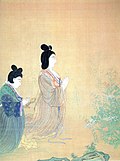 |
Fujiwara Asukabehime
藤原安宿媛 |
Emperor Shōmu |
729–749
(9 years) |
701–760
(58–59 years)
Daughter of Fujiwara no Fuhito. Gave birth to Empress Kōken and one other child. Empress dowager from 749. |
 |
Princess Inoe
井上内親王 |
Emperor Kōnin |
770–772
(2 years) |
717–775
(57–58 years)
Daughter of Emperor Shōmu; half-sister of Empress Kōken. Gave birth to Sakahito, as well as to Osabe who was named crown prince. Deposed in 772 after being accused of using curses and black magic to promote Osabe to the throne. |
 |
Fujiwara no Otomuro
藤原乙牟漏 |
Emperor Kanmu |
783–790
(6 years) |
760–790
(29–30 years)
Daughter of Fujiwara no Yoshitsugu. Gave birth to Emperor Heizei, Emperor Saga and Princess Koshi. Posthumously appointed empress dowager in 806. |
 |
Fujiwara no Tarashiko
藤原帯子 |
Emperor Heizei |
posthumously appointed in 806 |
died 794
Daughter of Fujiwara no Momokawa. Married Emperor Heizei before his accession to the throne. |
 |
Tachibana no Kachiko
橘嘉智子 |
Emperor Saga |
815–823
(7 years) |
786–850
(63–64 years)
Daughter of Tachibana no Kiyotomo. Married Emperor Saga in 809. Gave birth to Emperor Ninmyō, Princess Seishi and five other children. Empress dowager from 823 until 833. Grand empress dowager from 833. |
 |
Princess Koshi
高志内親王 |
Emperor Junna |
posthumously appointed in 823 |
789–809
(19–20 years)
Daughter of Emperor Kanmu and Fujiwara no Otomuro. Married Emperor Junna in 804. Gave birth to four children. |
 |
Princess Seishi
正子内親王 |
Emperor Junna |
827–833
(6 years) |
810–879
(68–69 years)
Daughter of Emperor Saga and Tachibana no Kachiko. Gave birth to three children. Empress dowager from 833 until 854. Grand empress dowager from 854. |
 |
Fujiwara no Onshi
藤原穏子 |
Emperor Daigo |
923–931
(7 years) |
885–954
(68–69 years)
Daughter of Fujiwara no Mototsune. Gave birth to Emperor Suzaku, Emperor Murakami and two other children. Empress dowager from 931 until 946. Grand empress dowager from 946. |
 |
Fujiwara no Anshi
藤原安子 |
Emperor Murakami |
958–964
(5 years) |
927–964
(68–69 years)
Daughter of Fujiwara no Morosuke. Gave birth to Emperor Reizei, Emperor En'yu and seven other children. |
 |
Princess Masako
昌子内親王 |
Emperor Reizei |
967–973
(5 years) |
950–1000
(49–50 years)
Daughter of Emperor Suzaku. Adopted one child. Empress dowager from 973 until 986. Grand empress dowager from 986. |
 |
Fujiwara no Koshi
藤原媓子 |
Emperor En'yū |
973–979
(5 years) |
947–979
(31–32 years)
Daughter of Fujiwara no Kanemichi. |
 |
Fujiwara no Junshi
藤原遵子 |
982–997
(15 years) |
957–1017
(59–60 years)
Daughter of Fujiwara no Yoritada. Empress dowager from 1000 until 1012. Grand empress dowager from 1012. |
 |
Fujiwara no Teishi
藤原定子 |
Emperor Ichijō |
990–1001
(10 years) |
977–1001
(23–24 years)
Daughter of Fujiwara no Michitaka. Gave birth to three children. |
 |
Fujiwara no Shōshi
藤原彰子 |
1000–1012
(12 years) |
988–1074
(86 years)
Daughter of Fujiwara no Michinaga. Gave birth to Emperor Go-Ichijō and Emperor Go-Suzaku. Empress dowager from 1012 to 1018. Grand empress dowager from 1018. |
 |
Fujiwara no Seishi
藤原娍子 |
Emperor Sanjō |
1012–1016
(4 years) |
972–1025
(52–53 years)
Daughter of Fujiwara no Naritoki. Gave birth to six children. |
 |
Fujiwara no Kenshi
藤原妍子 |
1012–1018
(6 years) |
994–1027
(32–33 years)
Daughter of Fujiwara no Michinaga. Gave birth to Princess Teishi. Empress dowager from 1018. |
 |
Fujiwara no Ishi
藤原威子 |
Emperor Go-Ichijō |
1018–1036
(18 years) |
1000–1036
(36 years)
Daughter of Fujiwara no Michinaga. Gave birth to Princess Shōshi (1027–1105) and Princess Kaoruko. |
 |
Princess Teishi
禎子内親王 |
Emperor Go-Suzaku |
1037–1051
(14 years) |
1013–1094
(80 years)
Daughter of Emperor Sanjō and Fujiwara no Kenshi (994–1027). Gave birth to Emperor Go-Sanjō and two other children. Empress dowager from 1051 until 1068. Grand empress dowager from 1068. |
 |
Fujiwara no Genshi
藤原嫄子 |
1037–1039
(2 years) |
1016–1039
(23 years)
Daughter of Prince Atsuyasu; granddaughter of Emperor Ichijō; adopted daughter of Fujiwara no Yorimichi. Gave birth to two children. |
 |
Princess Shōshi
章子内親王 |
Emperor Go-Reizei |
1046–1068
(22 years) |
1027–1105
(77–78 years)
Daughter of Emperor Go-Ichijō and Fujiwara no Ishi. Empress dowager from 1068 until 1069. Grand empress dowager from 1069. |
 |
Fujiwara no Hiroko
藤原寛子 |
1051–1069
(18 years) |
1036–1127
(90–91 years)
Daughter of Fujiwara no Yorimichi. Empress dowager from 1069 until 1074. Grand empress dowager from 1074. |
 |
Fujiwara no Kanshi
藤原歓子 |
1068–1074
(6 years) |
1021–1102
(80–81 years)
Daughter of Fujiwara no Norimichi. Gave birth to one child. Empress dowager from 1074. |
 |
Princess Kaoruko
馨子内親王 |
Emperor Go-Sanjō |
1069–1093[59]
(24 years) |
1029–1093
(63–64 years)
Daughter of Emperor Go-Ichijō. Married Emperor Go-Sanjō in 1051. |
 |
Fujiwara no Kenshi
藤原賢子 |
Emperor Shirakawa |
1074–1084
(10 years) |
1057–1084
(26–27 years)
Daughter of Minamoto Akifusa; adopted daughter of Fujiwara no Morozane. Gave birth to Emperor Horikawa and four other children. |
 |
Princess Yasuko
媞子内親王 |
Honorary; adoptive mother of Emperor Horikawa |
1091–1093
(2 years) |
1076–1096
(19–20 years)
Daughter of Emperor Shirakawa and Fujiwara no Kenshi (1057–1084); sister of Emperor Horikawa. |
 |
Princess Tokushi
篤子内親王 |
Emperor Horikawa |
1093–1107
(14 years) |
1060–1114
(53–54 years)
Daughter of Emperor Go-Sanjō and Princess Kaoruko. |
 |
Princess Reishi
令子内親王 |
Honorary; adoptive mother of Emperor Toba |
1108–1134
(26 years) |
1078–1144
(65–66 years)
Daughter of Emperor Shirakawa and Fujiwara no Kenshi (1057–1084); aunt of Emperor Toba. |
 |
Fujiwara no Tamako
藤原璋子 |
Emperor Toba |
1118–1124
(6 years) |
1101–1145
(43–44 years)
Daughter of Fujiwara no Kinzane. Raised by Emperor Shirakawa after losing her father when she was seven years old. Gave birth to Emperor Sutoku, Emperor Go-Shirakawa, Princess Muneko and four other children. |
 |
Fujiwara no Kiyoko
藤原聖子 |
Emperor Sutoku |
1130–1142
(12 years) |
1122–1182
(59–60 years)
Daughter of Fujiwara no Tadamichi. Empress dowager from 1142. |
 |
Fujiwara no Yasuko
藤原泰子 |
Emperor Toba |
1134–1139
(5 years) |
1095–1156
(60–61 years)
Daughter of Fujiwara no Tadazane. |
 |
Fujiwara no Nariko
藤原得子 |
1142–1149
(7 years) |
1117–1160
(42–43 years)
Daughter of Fujiwara no Nagazane. Gave birth to Emperor Konoe, Princess Yoshiko (1141–1176) and two other children. |
 |
Fujiwara no Tashi
藤原多子 |
Emperor Konoe |
1150–1156
(6 years) |
1140–1202
(61–62 years)
Daughter of Tokudaiji Kinyoshi; adopted daughter of Fujiwara no Yorinaga. Empress dowager from 1156. Grand empress dowager from 1158. Consort of Emperor Nijō from 1160 until 1165. Only empress to become the consort of two emperors. |
 |
Fujiwara no Teishi
藤原呈子 |
Emperor Konoe |
1150–1158
(7 years) |
1131–1176
(44–45 years)
Daughter of Fujiwara no Koremichi; adopted daughter of Fujiwara no Tadamichi. |
 |
Fujiwara no Kinshi
藤原忻子 |
Emperor Go-Shirakawa |
1156–1172
(7 years) |
1134–1209
(74–75 years)
Daughter of Tokudaiji Kinyoshi. Empress dowager from 1172. |
 |
Princess Muneko
統子内親王 |
Honorary; adoptive mother of Emperor Go-Shirakawa |
1158–1159
(11 months) |
1126–1189
(62 years)
Daughter of Emperor Toba and Fujiwara no Tamako; sister of Emperor Go-Shirakawa. |
 |
Princess Yoshiko
姝子内親王 |
Emperor Nijō |
1159–1162
(2 years) |
1141–1176
(34 years)
Daughter of Emperor Toba and Fujiwara no Nariko. |
 |
Fujiwara no Ikushi
藤原育子 |
1162–1173
(11 years) |
1146–1173
(26–27 years)
Daughter of Tokudaiji Saneyoshi; foster mother of Emperor Rokujō. |
 |
Taira no Tokuko
平徳子 |
Emperor Takakura |
1172–1182
(9 years) |
1155–1214
(58–59 years)
Daughter of Emperor Go-Shirakawa. Gave birth to Emperor Antoku. |
 |
Princess Sukeko
亮子内親王 |
Honorary; adoptive mother of Emperor Antoku
(until 1183)
Honorary; adoptive mother of Emperor Go-Toba
(from 1183) |
1182–1187
(4 years) |
1147–1216
(68–69 years)
Daughter of Emperor Go-Shirakawa; aunt of Emperor Antoku and Emperor Go-Toba. |
 |
Fujiwara no Ninshi
藤原任子 |
Emperor Go-Toba |
1190–1200
(10 years) |
1173–1239
(65 years)
Daughter of Fujiwara no Kanezane. Gave birth to Princess Shōshi (1195–1211). |
 |
Princess Noriko
範子内親王 |
Honorary; adoptive mother of Emperor Tsuchimikado |
1198–1206
(8 years) |
1177–1210
(32 years)
Daughter of Emperor Takakura; aunt of Emperor Tsuchimikado. |
 |
Fujiwara no Reishi
藤原麗子 |
Emperor Tsuchimikado |
1205–1210
(4 years) |
1185–1243
(57–58 years)
Daughter of Fujiwara no Yorizane. |
 |
Princess Shōshi
昇子内親王 |
Honorary; adoptive mother of Prince Morinari |
1208–1209
(8 months) |
1195–1211
(16 years)
Daughter of Emperor Go-Toba and Fujiwara no Ninshi; sister of Prince Morinari (later Emperor Juntoku). |
 |
Fujiwara no Ritsushi
九条立子 |
Emperor Juntoku |
1211–1222
(11 years) |
1192–1248
(55–56 years)
Daughter of Kujō Yoshitsune. Gave birth to Emperor Chūkyō and one other child. |
 |
Princess Kuniko
邦子内親王 |
Honorary; adoptive mother of Emperor Go-Horikawa |
1222–1224
(2 years) |
1209–1283
(73–74 years)
Daughter of Prince Morisada; granddaughter of Emperor Takakura; sister of Emperor Go-Horikawa. Surrogate mother to Emperor Kameyama. |
 |
Fujiwara no Ariko
藤原有子 |
Emperor Go-Horikawa |
1223–1227
(3 years) |
1207–1286
(78–79 years)
Daughter of Sanjō Kinfusa. |
 |
Fujiwara no Chōshi
藤原長子 |
1226–1229
(2 years) |
1218–1275
(56–57 years)
Daughter of Konoe Iezane. |
 |
Fujiwara no Shunshi
藤原竴子 |
1230–1233
(3 years) |
1218–1275
(56–57 years)
Daughter of Kujō Michiie. Gave birth to Emperor Shijō and one other child. |
 |
Princess Rishi
利子内親王 |
Honorary; adoptive mother of Emperor Shijō |
1233–1239
(6 years) |
1197–1251
(53–54 years)
Daughter of Prince Morisada; granddaughter of Emperor Takakura; aunt of Emperor Shijō. |
 |
Fujiwara no Kisshi
藤原姞子 |
Emperor Go-Saga |
1242–1248
(6 years) |
1225–1292
(66–67 years)
Daughter of Saionji Saneuji. Gave birth to Emperor Go-Fukakusa, Emperor Kameyama and three other children. |
 |
Princess Teruko
曦子内親王 |
Honorary; adoptive mother of Emperor Go-Saga |
1248–1251
(2 years) |
1224–1262
(37–38 years)
Daughter of Emperor Tsuchimikado; aunt of Emperor Go-Saga. |
 |
Fujiwara no Kimiko
藤原公子 |
Emperor Go-Fukakusa |
1257–1260
(2 years) |
1232–1304
(71–72 years)
Daughter of Saionji Saneuji. Gave birth to Princess Reishi (1270–1307) and one other child. |
 |
Fujiwara no Saneko
藤原佶子 |
Emperor Kameyama |
1261–1272
(11 years) |
1245–1272
(26–27 years)
Daughter of Tōin Saneo. Gave birth to Emperor Go-Uda and two other children. |
 |
Fujiwara no Kishi
藤原嬉子 |
1261–1269
(7 years) |
1252–1318
(65–66 years)
Daughter of Saionji Kinsuke. |
 |
Princess Reishi
姈子内親王 |
Emperor Go-Uda |
1285–1291
(5 years) |
1270–1307
(36 years)
Daughter of Emperor Go-Fukakusa and Fujiwara no Kimiko. |
 |
Saionji Shōshi
西園寺鏱子 |
Emperor Fushimi |
1288–1298
(9 years) |
1271–1342
(70–71 years)
Daughter of Saionji Sanekane. Poet. Adopted Emperor Go-Fushimi. |
 |
Fujiwara no Kinshi
藤原忻子 |
Emperor Go-Nijō |
1303–1308
(4 years) |
1283–1352
(68–69 years)
Daughter of Tokudaiji Kintaka. |
 |
Princess Shōshi
奨子内親王 |
Honorary Empress of Emperor Go-Daigo |
1319
(6 months) |
1286–1348
(62 years)
Daughter of Emperor Go-Uda; half-sister of Emperor Go-Daigo. |
 |
Saionji Kishi
西園寺禧子 |
Emperor Go-Daigo |
1319–1333
(14 years) |
after 1295 and before 1305–1333
(27–38 years)
Daughter of Saionji Sanekane. Poet. Married Emperor Go-Daigo in 1314. Gave birth to Princess Kanshi and one other child. Empress dowager from 1333. |
 |
Princess Junshi
珣子内親王 |
1334–1337
(3 years) |
1311–1337
(25–26 years)
Daughter of Emperor Go-Fushimi. Gave birth to one child. |
 |
Daughter of Saionji Kinshige |
Emperor Chōkei |
appointed as early as 1371 |
Name unknown. Gave birth to one child. |
 |
Tokugawa Masako
徳川和子 |
Emperor Go-Mizunoo |
1624–1629
(5 years) |
1607–1678
(70 years)
Daughter of Tokugawa Hidetada. Gave birth to Empress Meishō and six other children. Adopted Emperor Go-Kōmyō and Emperor Go-Sai. |
 |
Takatsukasa Fusako
鷹司房子 |
Emperor Reigen |
1683–1687
(3 years) |
1653–1712
(58 years)
Daughter of Takatsukasa Norihira. Gave birth to one child. |
 |
Princess Yukiko
幸子女王 |
Emperor Higashiyama |
1708–1710
(2 years) |
1680–1720
(39 years)
Daughter of Prince Arisugawa Yukihito. Gave birth to one child. |
 |
Princess Yoshiko
欣子内親王 |
Emperor Kōkaku |
1794–1820
(26 years) |
1779–1846
(67 years)
Daughter of Emperor Go-Momozono. Last daughter of an emperor to become empress. Gave birth to two children. Adopted Emperor Ninkō. Empress dowager from 1820. |
 |
Takatsukasa Tsunako
鷹司繋子 |
Emperor Ninkō |
posthumously appointed in 1824 |
1798–1823
(24–25 years)
Daughter of Takatsukasa Masahiro. Married Emperor Ninkō in 1817. Gave birth to two children. |
 |
Ichijō Masako
一条勝子 |
Emperor Meiji |
11 January 1869
–
30 July 1912
(43 years, 201 days) |
9 May 1849
–
9 April 1914
(64 years, 335 days)
Daughter of Tadayoshi Ichijō.
Married Emperor Meiji on 11 January 1869.
Adopted Emperor Taishō (son of Emperor Meiji and Yanagiwara Naruko).
Empress dowager from her husband's death in 1912 until her death in 1914. |
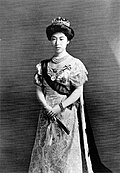 |
Kujō Sadako
九条節子 |
Emperor Taishō |
30 July 1912
–
25 December 1926
(14 years, 148 days) |
25 June 1884
–
17 May 1951
(66 years, 327 days)
Daughter of Kujō Michitaka.
Married Emperor Taishō on 10 May 1900.
Gave birth to four sons.
Empress Dowager from her husband's death in 1926 until her death in 1951. |
 |
Princess Nagako
良子女王 |
Emperor Shōwa |
25 December 1926
–
7 January 1989
(62 years, 13 days) |
6 March 1903
–
16 June 2000
(97 years, 92 days)
Daughter of Prince Kuni Kuniyoshi.
Married Emperor Shōwa on 26 January 1924.
Gave birth to seven children.
Empress Dowager from her husband's death in 1989 until her death in 2000. |
 |
Shōda Michiko
正田美智子 |
Akihito |
7 January 1989
–
30 April 2019
(30 years, 113 days) |
born 20 October 1934
(91 years, 60 days)
Daughter of Hidesaburō Shōda.
Married Akihito on 10 April 1959.
Gave birth to three children.
Empress Emerita from her husband's abdication in 2019. |
 |
Owada Masako
小和田雅子 |
Naruhito |
1 May 2019
–
present
(6 years, 232 days) |
born 9 December 1963
(62 years, 10 days)
Daughter of Hisashi Owada.
Married Naruhito on 9 June 1993.
Gave birth to one daughter. |
